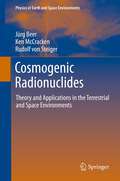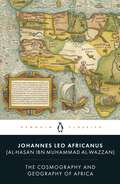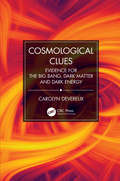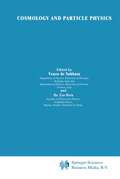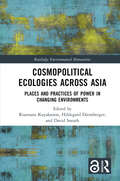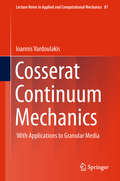- Table View
- List View
The Cosmic Zoo: Complex Life on Many Worlds
by Dirk Schulze-Makuch William BainsAre humans a galactic oddity, or will complex life with human abilities develop on planets with environments that remain habitable for long enough? In a clear, jargon-free style, two leading researchers in the burgeoning field of astrobiology critically examine the major evolutionary steps that led us from the distant origins of life to the technologically advanced species we are today. Are the key events that took life from simple cells to astronauts unique occurrences that would be unlikely to occur on other planets? By focusing on what life does - it's functional abilities - rather than specific biochemistry or anatomy, the authors provide plausible answers to this question. Systematically exploring the various pathways that led to the complex biosphere we experience on planet Earth, they show that most of the steps along that path are likely to occur on any world hosting life, with only two exceptions: One is the origin of life itself – if this is a highly improbable event, then we live in a rather “empty universe”. However, if this isn’t the case, we inevitably live in a universe containing a myriad of planets hosting complex as well as microbial life - a “cosmic zoo”. The other unknown is the rise of technologically advanced beings, as exemplified on Earth by humans. Only one technological species has emerged in the roughly 4 billion years life has existed on Earth, and we don’t know of any other technological species elsewhere. If technological intelligence is a rare, almost unique feature of Earth's history, then there can be no visitors to the cosmic zoo other than ourselves. Schulze-Makuch and Bains take the reader through the history of life on Earth, laying out a consistent and straightforward framework for understanding why we should think that advanced, complex life exists on planets other than Earth. They provide a unique perspective on the question that puzzled the human species for centuries: are we alone?
Cosmochemistry and the Origin of Life: Proceedings of the NATO Advanced Study Institute held at Maratea, Italy, June 1–12, 1981 (Nato Science Series C: #101)
by Cyril PonnamperumaFor the first time in human history, developments in many branches of science provide us with an opportunity of formula ting a comprehensive picture of the universe from its beginning to the present time. It is an awesome reflection that the carbon in our bodies is the very carbon which was generated during the birth of a star. There is a perceptible continuum through the billions of years which can be revealed by the study of chemistry. Studies in nucleosynthesis have related the origin of the elements to the life history of the stars. The chemical elements we find on earth, HYdrogen, Carbon, Oxygen, and Nitrogen, were created in astronomical processes that took place in the past, and these elements are not spread throughout space in the form of stars and galaxies. Radioastronomers have discovered a vast array of organic molecules in the interstellar medium which have a bearing on prebiological chemical processes. Many of the molecules found so far contain the four elements, C, N, 0, H. Except for the chem ically unreactive He, these four elements are the most abundant in the galaxy. The origin of polyatomic interstellar molecules is an unresolved problem. While we can explain the formation of some diatomic molecules as due to two atom collisions, it is much more difficult to form polyatomic molecules by collisions between diatomic molecules and atoms. There may be other produc tion mechanisms at work such as reactions taking place on the surface of interstellar dust grains.
Cosmogenic Radionuclides: Theory and Applications in the Terrestrial and Space Environments (Physics of Earth and Space Environments)
by Jürg Beer Ken McCracken Rudolf SteigerCosmogenic radionuclides are radioactive isotopes which are produced by natural processes and distributed within the Earth system. With a holistic view of the environment the authors show in this book how cosmogenic radionuclides can be used to trace and to reconstruct the history of a large variety of processes. They discuss the way in which cosmogenic radionuclides can assist in the quantification of complex processes in the present-day environment. The book aims to demonstrate to the reader the strength of analytic tools based on cosmogenic radionuclides, their contribution to almost any field of modern science, and how these tools may assist in the solution of many present and future problems that we face here on Earth. The book provides a comprehensive discussion of the basic principles behind the applications of cosmogenic (and other) radionuclides as environmental tracers and dating tools. The second section of the book discusses in some detail the production of radionuclides by cosmic radiation, their transport and distribution in the atmosphere and the hydrosphere, their storage in natural archives, and how they are measured. The third section of the book presents a number of examples selected to illustrate typical tracer and dating applications in a number of different spheres (atmosphere, hydrosphere, geosphere, biosphere, solar physics and astronomy). At the same time the authors have outlined the limitations of the use of cosmogenic radionuclides. Written on a level understandable by graduate students without specialist skills in physics or mathematics, the book addresses a wide audience, ranging from archaeology, biophysics, and geophysics, to atmospheric physics, hydrology, astrophysics and space science.
The Cosmography and Geography of Africa
by Leo AfricanusThe first new translation in over 400 years of one of the great works of the Renaissance: an African diplomat's guide to Africa.In 1518, al-Hasan ibn Muhammad al-Wazzan, a Moroccan diplomat, was seized by pirates while travelling in the Mediterranean. Brought before Pope Leo X, he was persuaded to convert to Christianity, in the process taking the name Johannes Leo Africanus. Acclaimed in the papal court for his learning, Leo would in time write his masterpiece, The Cosmography and the Geography of Africa.The Cosmography was the first book about Africa, and the first book written by a modern African, to reach print. It would remain central to the European understanding of Africa for over 300 years, with its descriptions of lands, cities and peoples giving a singular vision of the vast continent: its urban bustle and rural desolation, its culture, commerce and warfare, its magical herbs and strange animals.Yet it is not a mere catalogue of the exotic: Leo also invited his readers to acknowledge the similarity and relevance of these lands to the time and place they knew. For this reason, The Cosmography and Geography of Africa remains significant to our understanding not only of Africa, but of the world and how we perceive it.
Cosmological and Black Hole Apparent Horizons (Lecture Notes in Physics #907)
by Valerio FaraoniThis book overviews the extensive literature on apparent cosmological and black hole horizons. In theoretical gravity, dynamical situations such as gravitational collapse, black hole evaporation, and black holes interacting with non-trivial environments, as well as the attempts to model gravitational waves occurring in highly dynamical astrophysical processes, require that the concept of event horizon be generalized. Inequivalent notions of horizon abound in the technical literature and are discussed in this manuscript.The book begins with a quick review of basic material in the first one and a half chapters, establishing a unified notation. Chapter 2 reminds the reader of the basic tools used in the analysis of horizons and reviews the various definitions of horizons appearing in the literature. Cosmological horizons are the playground in which one should take baby steps in understanding horizon physics. Chapter 3 analyzes cosmological horizons, their proposed thermodynamics, and several coordinate systems. The remaining chapters discuss analytical solutions of the field equations of General Relativity, scalar-tensor, and f(R) gravity which exhibit time-varying apparent horizons and horizons which appear and/or disappear in pairs. An extensive bibliography enriches the volume. The intended audience is master and PhD level students and researchers in theoretical physics with knowledge of standard gravity.
Cosmological Applications of Algebraic Quantum Field Theory in Curved Spacetimes (SpringerBriefs in Mathematical Physics #6)
by Thomas-Paul HackThis book provides a largely self-contained and broadly accessible exposition on two cosmological applications of algebraic quantum field theory (QFT) in curved spacetime: a fundamental analysis of the cosmological evolution according to the Standard Model of Cosmology; and a fundamental study of the perturbations in inflation. The two central sections of the book dealing with these applications are preceded by sections providing a pedagogical introduction to the subject. Introductory material on the construction of linear QFTs on general curved spacetimes with and without gauge symmetry in the algebraic approach, physically meaningful quantum states on general curved spacetimes, and the backreaction of quantum fields in curved spacetimes via the semiclassical Einstein equation is also given. The reader should have a basic understanding of General Relativity and QFT on Minkowski spacetime, but no background in QFT on curved spacetimes or the algebraic approach to QFT is required.>
Cosmological Clues: Evidence for the Big Bang, Dark Matter and Dark Energy
by Carolyn DevereuxDid the Universe have a beginning? Will it have an end? Or has it always been the same, never changing? This is the subject of cosmology; the study of the Universe, and this book provides a perfect introduction to the subject for anyone that is interested in the wonders of our UniverseThis book provides an accessible overview of the Standard Model of Cosmology, which is explained in six Cosmological Clues, including evidence for the Big Bang and dark matter and dark energy - the keystones of modern cosmology. It takes readers through some of the most exciting questions in cosmology, such as what evidence do we have that the Universe started from the Big Bang? Has dark matter been observed? Will we ever know what dark energy is? Are the multiverses real? And could the Universe be a hologram? This book is an ideal guide for anyone interested in finding out more about our Universe. It will be of interest to those studying cosmology for the first time, including readers without a scientific background, who have an interest in looking up at the stars and wondering where they all came from!Key features: Contains the latest evidence for the Big Bang, dark matter, and dark energy and explores exciting scientific ideas, such as inflation and multiverses Provides a clear explanation of the main theories of how the Universe evolved based on key observations - the Cosmological Clues Gives the reader a concise introduction to the scientific process, using cosmology as the example, and explores why it has been so successful in creating the technologies we have today
Cosmological Clues: Evidence for the Big Bang, Dark Matter and Dark Energy
by Carolyn DevereuxDid the Universe have a beginning? Will it have an end? Or has it always been the same, never changing? This is the subject of cosmology; the study of the Universe, and this book provides a perfect introduction to the subject for anyone that is interested in the wonders of our UniverseThis book provides an accessible overview of the Standard Model of Cosmology, which is explained in six Cosmological Clues, including evidence for the Big Bang and dark matter and dark energy - the keystones of modern cosmology. It takes readers through some of the most exciting questions in cosmology, such as what evidence do we have that the Universe started from the Big Bang? Has dark matter been observed? Will we ever know what dark energy is? Are the multiverses real? And could the Universe be a hologram? This book is an ideal guide for anyone interested in finding out more about our Universe. It will be of interest to those studying cosmology for the first time, including readers without a scientific background, who have an interest in looking up at the stars and wondering where they all came from!Key features: Contains the latest evidence for the Big Bang, dark matter, and dark energy and explores exciting scientific ideas, such as inflation and multiverses Provides a clear explanation of the main theories of how the Universe evolved based on key observations - the Cosmological Clues Gives the reader a concise introduction to the scientific process, using cosmology as the example, and explores why it has been so successful in creating the technologies we have today
Cosmological Crossroads: An Advanced Course in Mathematical, Physical and String Cosmology (Lecture Notes in Physics #592)
by Spiros Cotsakis Eleftherios PapantonopoulosCosmological Probes of Light Relics (Springer Theses)
by Benjamin WallischThe wealth of recent cosmic microwave background and large-scale structure data has transformed the field of cosmology. These observations have not only become precise enough to answer questions about the universe on the largest scales, but also to address puzzles in the microscopic description of Nature. This thesis investigates new ways of probing the early universe, the properties of neutrinos and the possible existence of other light particles. In particular, based on detailed theoretical insights and novel analyses, new evidence for the cosmic neutrino background is found in the distribution of galaxies and in cosmic microwave background data. This tests the Standard Model of particle physics and the universe back to a time when it was about one second old. Furthermore, it is demonstrated that future observations will be capable of probing physics beyond the Standard Model since they can achieve a particular target which would either allow the detection of any light particles that have ever been in thermal equilibrium or imply strong bounds on their properties.
Cosmological Readings of Contemporary Australian Literature: Unsettling the Anthropocene (Routledge Environmental Literature, Culture and Media)
by Kathrin Bartha-MitchellThis book presents an innovative and imaginative reading of contemporary Australian literature in the context of unprecedented ecological crisis. The Australian continent has seen significant, rapid changes to its cultures and land-use from the impact of British colonial rule, yet there is a rich history of Indigenous land-ethics and cosmological thought. By using the age-old idea of ‘cosmos’—the order of the world—to foreground ideas of a good order and chaos, reciprocity and more-than-human agency, this book interrogates the Anthropocene in Australia, focusing on notions of colonisation, farming, mining, bioethics, technology, environmental justice and sovereignty. It offers ‘cosmological readings’ of a diverse range of authors—Indigenous and non-Indigenous—as a challenge to the Anthropocene’s decline-narrative. As a result, it reactivates ‘cosmos’ as an ethical vision and a transculturally important counter-concept to the Anthropocene. Kathrin Bartha-Mitchell argues that the arts can help us envision radical cosmologies of being in and with the planet, and to address the very real social and environmental problems of our era. This book will be of particular interest to scholars and students of Ecocriticism, Environmental Humanities, and postcolonial, transcultural and Indigenous studies, with a primary focus on Australian, New Zealand, Oceanic and Pacific area studies.
Cosmological Readings of Contemporary Australian Literature: Unsettling the Anthropocene (Routledge Environmental Literature, Culture and Media)
by Kathrin Bartha-MitchellThis book presents an innovative and imaginative reading of contemporary Australian literature in the context of unprecedented ecological crisis. The Australian continent has seen significant, rapid changes to its cultures and land-use from the impact of British colonial rule, yet there is a rich history of Indigenous land-ethics and cosmological thought. By using the age-old idea of ‘cosmos’—the order of the world—to foreground ideas of a good order and chaos, reciprocity and more-than-human agency, this book interrogates the Anthropocene in Australia, focusing on notions of colonisation, farming, mining, bioethics, technology, environmental justice and sovereignty. It offers ‘cosmological readings’ of a diverse range of authors—Indigenous and non-Indigenous—as a challenge to the Anthropocene’s decline-narrative. As a result, it reactivates ‘cosmos’ as an ethical vision and a transculturally important counter-concept to the Anthropocene. Kathrin Bartha-Mitchell argues that the arts can help us envision radical cosmologies of being in and with the planet, and to address the very real social and environmental problems of our era. This book will be of particular interest to scholars and students of Ecocriticism, Environmental Humanities, and postcolonial, transcultural and Indigenous studies, with a primary focus on Australian, New Zealand, Oceanic and Pacific area studies.
Cosmology and Particle Physics (Nato Science Series C: #427)
by V. De Sabbata Ho Ho Tso-HsiuIn recent years there has been a steadily increasing cross-fertilization between cosmology and particle physics, on both the theoretical and experimental levels. Particle physics has provided new experimental data from the big accelerators in operation, and data from space satellites are accumulating rapidly. Cosmology is still one of the best laboratories for testing particle theory. The present work discusses such matters in the context of inflation, strings, dark matter, neutrinos and gravitational wave physics in the very early universe, field theory at the Planck scale, and high energy physics. A particular emphasis has been placed on a new topology for spatial infinity, on the relation between temperature and gravitational potential, a canonical formulation of general relativity, the neutrino mass, spin in the early universe, the measurement of gravity in the 10--100 m range, galaxy--galaxy and cluster--cluster correlation, black holes, string theory and string/string duality. The work also presents a beautiful review of high energy elementary particle physics, treating the meaning, status and perspectives of unification and standard model gauge couplings.
Cosmology in Scalar-Tensor Gravity (Fundamental Theories of Physics #139)
by Valerio FaraoniCosmology in Scalar-Tensor Gravity covers all aspects of cosmology in scalar-tensor theories of gravity. Considerable progress has been made in this exciting area of physics and this book is the first to provide a critical overview of the research. Among the topics treated are: -Scalar-tensor gravity and its limit to general relativity, -Effective energy-momentum tensors and conformal frames, -Gravitational waves in scalar-tensor cosmology, -Specific scalar-tensor theories, -Exact cosmological solutions and cosmological perturbations, -Scalar-tensor scenarios of the early universe and inflation, -Scalar-tensor models of quintessence in the present universe and their far-reaching consequences for the ultimate fate of the cosmos.
The Cosmology of Extra Dimensions and Varying Fundamental Constants: A JENAM 2002 Workshop Porto, Portugal 3–5 September 2002
by Carlos MartinsThe workshop on The Cosmology of Extra Dimensions and Varying Fundamental Constants, which was part of JENAM 2002, was held at the Physics Department of the University of Porto (FCUP) from the 3rd to the 5th of September 2002. It was regularly attended by about 110 participants, of which 65 were officially registered in the VFC workshop, while the others came from the rest of the JENAM workshops. There were also a few science correspondents from the national and international press. During the 3 days of the scientific programme, 8 Invited Reviews and 30 Oral Communications were presented. The speakers came from 11 different European countries, and also from Argentina, Australia, Canada, Japan and the U.S.A. There were also speakers from six Portuguese research institutions, and nine of the speak ers were Ph.D. students. The contributions are presented in these proceedings in chronological order. The workshop brought together string theorists, particle physicists, theoretical and observational cosmologists, relativists and observational astrophysicists. It was generally agreed that this inter-disciplinarity was the greatest strength of the work shop, since it provided people coming into this very recent topic from the various different backgrounds with an opportunity to understand each other's language and thereby gain a more solid understanding of the overall picture.
Cosmology, Quantum Vacuum and Zeta Functions: In Honor of Emilio Elizalde (Springer Proceedings in Physics #137)
by Sergey D. Odintsov Diego Sáez-Gómez Prof. S. Xambó-Descamps Universitat Po CatalunySome major developments of physics in the last three decades are addressed by highly qualified specialists in different specific fields. They include renormalization problems in QFT, vacuum energy fluctuations and the Casimir effect in different configurations, and a wealth of applications. A number of closely related issues are also considered. The cosmological applications of these theories play a crucial role and are at the very heart of the book; in particular, the possibility to explain in a unified way the whole history of the evolution of the Universe: from primordial inflation to the present day accelerated expansion. Further, a description of the mathematical background underlying many of the physical theories considered above is provided. This includes the uses of zeta functions in physics, as in the regularization problems in QFT already mentioned, specifically in curved space-time, and in Casimir problems as.
Cosmopolitan Europe: A Strasbourg Self-Portrait
by John WesternThe past hundred years of Europe are distilled in the experiences of the citizens of Strasbourg. From the turn of the twentieth century until 1945, Europe's ruling idea of nationalism rendered Strasbourg/Straßburg the prize in a tug-of-war between the two greatest continental powers, France and Germany. Then, in the immediate post-war period, ideals for European unity set up various European institutions, some headquartered in Strasbourg, which have gradually created a partially supranational Europe. At the end of the 1950s, a third theme arises: the large-scale settling in Strasbourg and other such richer, western European cities of persons from poorer lands, frequently ex-colonial territories, whose appearance and cultural practices render them essentially "different" to local eyes: expressions of racism thereby jostle with professions of multiculturalism. Now in the globalisation era, the issue of "immigration" has broadened yet further into transnationalism: the experience of persons who are embedded in varying manner in both Strasbourg and in their land of origin. Based on in-depth, lively interviews with 80 men and 80 women ranging from 101 to 20 years, and from all over the world (France, Germany, Alsace-Lorraine, Portugal, Italy, ex-Yugoslavia, Albania, Algeria, Morocco, Turkey, Cameroon, and Afghanistan amongst other countries), the author draws out of these compelling testimonies all sorts of compelling insights into issues of identity, race, nationality, culture, politics, heritage and representation, giving a unique and valuable view of what it means (and has meant over the past century) to be a European.
Cosmopolitan Europe: A Strasbourg Self-Portrait
by John WesternThe past hundred years of Europe are distilled in the experiences of the citizens of Strasbourg. From the turn of the twentieth century until 1945, Europe's ruling idea of nationalism rendered Strasbourg/Straßburg the prize in a tug-of-war between the two greatest continental powers, France and Germany. Then, in the immediate post-war period, ideals for European unity set up various European institutions, some headquartered in Strasbourg, which have gradually created a partially supranational Europe. At the end of the 1950s, a third theme arises: the large-scale settling in Strasbourg and other such richer, western European cities of persons from poorer lands, frequently ex-colonial territories, whose appearance and cultural practices render them essentially "different" to local eyes: expressions of racism thereby jostle with professions of multiculturalism. Now in the globalisation era, the issue of "immigration" has broadened yet further into transnationalism: the experience of persons who are embedded in varying manner in both Strasbourg and in their land of origin. Based on in-depth, lively interviews with 80 men and 80 women ranging from 101 to 20 years, and from all over the world (France, Germany, Alsace-Lorraine, Portugal, Italy, ex-Yugoslavia, Albania, Algeria, Morocco, Turkey, Cameroon, and Afghanistan amongst other countries), the author draws out of these compelling testimonies all sorts of compelling insights into issues of identity, race, nationality, culture, politics, heritage and representation, giving a unique and valuable view of what it means (and has meant over the past century) to be a European.
Cosmopolitan Place Making in Australia: Immigrant Minorities and the Built Environment in Cities, Regional and Rural Areas
by Jock Collins Branka Krivokapic-Skoko Kirrily Jordan Hurriyet Babacan Narayan GopalkrishnanThis book looks at the historical and contemporary impact of minority immigrant and ethnic communities on the built and social environment in Australian cities, rural and regional areas. The emphasis is on the changing social use of these buildings – places of worship, ethnic clubs and community associations, immigrant restaurants and retail outlets, museums, memorials and landmarks and other places and spaces created by immigrant communities – rather than on their architectural merit. These places and spaces are sites of bridging and bonding social capital, of social interaction between immigrant communities and their local communities. In both the Australian cities and the ‘bush’ (an Australian colloquial term for non-metropolitan dwellers), the book investigates how the places built and used by minority ethnic communities have transformed Australian life in complex and sometimes contradictory ways. In Sydney, Brisbane and Perth, the book investigates the historical development of Chinatowns and their contemporary dynamics.
Cosmopolitan Urbanism
by Jon Binnie Julian Holloway Steve Millington Craig YoungIn order to attract investment and tourism, cities are increasingly competing to re-brand themselves as cosmopolitan, and in recent years, cosmopolitanism has become the focus of considerable critical attention in academia. Here, renowned editors and contributors have come together to produce one of the first books to tackle cosmopolitanism from a geographical perspective. Central to the cosmopolitan process is how traditionally marginalized groups have become re-valued and reconstructed as a resource in the eyes of planners and politicians. This fascinating book examines the politics of these transformations by understanding the everyday practices of cosmopolitanism. Which forms of cultural difference are valued and which are excluded from this re-visioning of the contemporary city? Organized in three distinct parts, the book covers: production and consumption, and cosmopolitanism the spatialities of cosmopolitanism the deployment, mobilization and articulation of cosmopolitan discourses in policy-making and urban design. The volume is groundbreaking in examining the complex politics of cosmopolitanism in empirical case studies from Montreal to Singapore, London to Texas, Auckland to Amsterdam. With a strong editorial steer, including general and section introductions and a conclusion to guide the student reader, Cosmopolitan Urbanism employs a range of theoretical and empirical approaches to provide a grounded treatment essential for students of human geography, urban studies and sociology.
Cosmopolitan Urbanism
by Jon Binnie Julian Holloway Steve Millington Craig YoungIn order to attract investment and tourism, cities are increasingly competing to re-brand themselves as cosmopolitan, and in recent years, cosmopolitanism has become the focus of considerable critical attention in academia. Here, renowned editors and contributors have come together to produce one of the first books to tackle cosmopolitanism from a geographical perspective. Central to the cosmopolitan process is how traditionally marginalized groups have become re-valued and reconstructed as a resource in the eyes of planners and politicians. This fascinating book examines the politics of these transformations by understanding the everyday practices of cosmopolitanism. Which forms of cultural difference are valued and which are excluded from this re-visioning of the contemporary city? Organized in three distinct parts, the book covers: production and consumption, and cosmopolitanism the spatialities of cosmopolitanism the deployment, mobilization and articulation of cosmopolitan discourses in policy-making and urban design. The volume is groundbreaking in examining the complex politics of cosmopolitanism in empirical case studies from Montreal to Singapore, London to Texas, Auckland to Amsterdam. With a strong editorial steer, including general and section introductions and a conclusion to guide the student reader, Cosmopolitan Urbanism employs a range of theoretical and empirical approaches to provide a grounded treatment essential for students of human geography, urban studies and sociology.
Cosmopolitical Ecologies Across Asia: Places and Practices of Power in Changing Environments (ISSN)
by Riamsara Kuyakanon Hildegard Diemberger David SneathCosmopolitical Ecologies Across Asia offers a unique insight into the non-human and spiritual dimensions of environmental management in a changing world.This volume presents a comparative, place-based exploration of landscapes across Asia and the entities, practices and knowledges that inhabit them. Rather than treating sacred mountains, terrains and water sources as self-contained, esoteric religious phenomena, the authors consider them within critical 'cosmopolitical ecologies' framings in which non-human entities are engaged as actors in the socio-political arena. The chapters include case studies of healing springs recognized by governments, and sacred mountains that are addressed by heads of states and Communist Party cadres, or that speak to the faithful through spirit mediums in a politics of re-enchantment. Contributors explore the diverse ways in which non-human entities such as forest spirits, reindeer, mountains and Buddhist Masters of the Land are engaged by humans to navigate environmental change and address a range of ecological threats from large-scale mining to climate change. Cosmopolitical ecologies approaches encompass the healing power of topography as well as transformative intimacies with other-than-human beings such as sparrows within an Islamic eco-theological poetic setting. In this light the book observes dynamic and creative processes of cosmological innovation including the repurposing of ritual to address challenges such as the Covid-19 epidemic.This book will be of great interest to students and scholars of environment and society across disciplinary perspectives in general, and to anthropologists, human geographers, political ecologists, indigenous studies, area studies, environmental sciences and environmental humanities scholars in particular.The Introduction to this book is freely available as a downloadable Open Access PDF at http://www.taylorfrancis.com under a Creative Commons Attribution-Non Commercial-No Derivatives (CC-BY-NC-ND) 4.0 license.
Cosmopolitical Ecologies Across Asia: Places and Practices of Power in Changing Environments (ISSN)
by Riamsara Kuyakanon Hildegard Diemberger David SneathCosmopolitical Ecologies Across Asia offers a unique insight into the non-human and spiritual dimensions of environmental management in a changing world.This volume presents a comparative, place-based exploration of landscapes across Asia and the entities, practices and knowledges that inhabit them. Rather than treating sacred mountains, terrains and water sources as self-contained, esoteric religious phenomena, the authors consider them within critical 'cosmopolitical ecologies' framings in which non-human entities are engaged as actors in the socio-political arena. The chapters include case studies of healing springs recognized by governments, and sacred mountains that are addressed by heads of states and Communist Party cadres, or that speak to the faithful through spirit mediums in a politics of re-enchantment. Contributors explore the diverse ways in which non-human entities such as forest spirits, reindeer, mountains and Buddhist Masters of the Land are engaged by humans to navigate environmental change and address a range of ecological threats from large-scale mining to climate change. Cosmopolitical ecologies approaches encompass the healing power of topography as well as transformative intimacies with other-than-human beings such as sparrows within an Islamic eco-theological poetic setting. In this light the book observes dynamic and creative processes of cosmological innovation including the repurposing of ritual to address challenges such as the Covid-19 epidemic.This book will be of great interest to students and scholars of environment and society across disciplinary perspectives in general, and to anthropologists, human geographers, political ecologists, indigenous studies, area studies, environmental sciences and environmental humanities scholars in particular.The Introduction to this book is freely available as a downloadable Open Access PDF at http://www.taylorfrancis.com under a Creative Commons Attribution-Non Commercial-No Derivatives (CC-BY-NC-ND) 4.0 license.
Cosserat Continuum Mechanics: With Applications to Granular Media (Lecture Notes in Applied and Computational Mechanics #87)
by Ioannis VardoulakisThis textbook explores the theory of Cosserat continuum mechanics, and covers fundamental tools, general laws and major models, as well as applications to the mechanics of granular media. While classical continuum mechanics is based on the axiom that the stress tensor is symmetric, theories such as that expressed in the seminal work of the brothers Eugène and François Cosserat are characterized by a non-symmetric stress tensor. The use of von Mises motor mechanics is introduced, for the compact mathematical description of the mechanics and statics of Cosserat continua, as the Cosserat continuum is a manifold of oriented “rigid particles” with 3 dofs of displacement and 3 dofs of rotation, rather than a manifold of points with 3 dofs of displacement. Here, the analysis is restricted to infinitesimal particle displacements and rotations. This book is intended as a valuable supplement to standard Continuum Mechanics courses, and graduate students as well as researchers in mechanics and applied mathematics will benefit from its self-contained text, which is enriched by numerous examples and exercises.
Cost-Benefit Analyses of Climate Change: The Broader Perspectives
by Ferenc TothThe Potsdam Institute for Climate Impact Research (PIK) was founded in 1992 as a "Blue List" research institute, with the Federal Ministry for Education, Science, Research and Technology and the Ministry for Science, Research and Culture of the federal state of Brandenburg each provid ing half ofthe funding. PIK currently has a staff of 100 (1997), including about 75 scientists and guest scientists, as well as a number of students and temporary assistants. Further expansion is taking place at the institute site in the "Albert Einstein" Science Park in Potsdam. The interdisciplinary nature of climate impact research, especially the interface between the natural scientific and socioeconomic dimensions of environmental research, is reflected at PIK in the close cooperation with partner institutes at national and international level. The flexible frame work created for the institute enables new problems and issues to be taken up as they arise. As a center of scientific innovation, PIK also coordinates international activities in the fields of climate impact research and Earth System analysis. The institute houses project offices for the IGBP international research programs, for example. Simulations of Global Change are performed on PIK's supercomputer using models and data drawn from various disciplines. The parallel compu ter (an IBM-SP2) boasts 20 gigaflops of computing power, making it one of the most powerful research computers in Germany. The Workshop on Cost-Benefit Analyses of Climate Change was jointly organized by PIK and the Wuppertal Institute for Energy, Climate, and Environment (WI).


